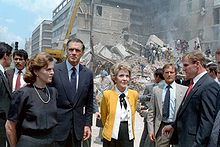20th Century to present
 Mexsuites Casa Azul Bed and Breakfast Mexico City
Mexsuites Casa Azul Bed and Breakfast Mexico City
The history of the rest of the 20th century to the present focuses on the phenomenal growth of the city and its environmental and political consequences. In 1900, the population of Mexico City was about 500,000. The city began to grow rapidly westward in the early part of the 20th century and then began to grow upwards in the 1950s, with the Torre Latinoamericana becoming the city’s first skyscraper.
The rapid development of Mexico City as a center for modernist architecture was most fully manifested in the mid-1950s construction of the Ciudad Universitaria, Mexico City, the main campus of the National Autonomous University of Mexico. Designed by the most prestigious architects of the era, including Mario Pani, Eugenio Peschard, and Enrique del Moral, the buildings feature murals by artists Diego Rivera, David Alfaro Siqueiros, and José Chávez Morado. It has since been recognized as a UNESCO World Heritage Site.

The 1968 Olympic Games brought about the construction of large sporting facilities. In 1969, the Metro system was inaugurated. Explosive growth in the population of the city started in the 1960s, with the population overflowing the boundaries of the Federal District into the neighboring State of Mexico, especially to the north, northwest, and northeast. Between 1960 and 1980 the city’s population more than doubled to nearly 9 million.
In 1980 half of all the industrial jobs in Mexico were located in Mexico City. Under relentless growth, the Mexico City government could barely keep up with services. Villagers from the countryside who continued to pour into the city to escape poverty only compounded the city’s problems. With no housing available, they took over lands surrounding the city, creating huge shantytowns that extended for many miles. This caused serious air pollution in Mexico City and water pollution problems, as well as subsidence due to overextraction of groundwater. Air and water pollution has been contained and improved in several areas due to government programs, the renovation of vehicles and the modernization of public transportation.
The autocratic government that ruled Mexico City since the Revolution was tolerated, mostly because of the continued economic expansion since World War II. This was the case even though this government could not handle the population and pollution problems adequately. Nevertheless, discontent and protests began in the 1960s leading to the massacre of an unknown number of protesting students in Tlatelolco.
Three years later, a demonstration in the Maestros avenue, organized by former members of the 1968 student movement, was violently repressed by a paramilitary group called “Los Halcones”, composed of gang members and teenagers from many sports clubs who received training in the U.S.
On Thursday, 19 September 1985, at 7:19 am CST, Mexico City was struck by an earthquake of magnitude 8.1 on the Richter magnitude scale. Although this earthquake was not as deadly or destructive as many similar events in Asia and other parts of Latin America, it proved to be a disaster politically for the one-party government. The government was paralyzed by its own bureaucracy and corruption, forcing ordinary citizens to create and direct their own rescue efforts and to reconstruct much of the housing that was lost as well.

However, the last straw may have been the controversial elections of 1988. That year, the presidency was set between the P.R.I.’s candidate, Carlos Salinas de Gortari, and a coalition of left-wing parties led by Cuauhtémoc Cárdenas, son of the former president Lázaro Cárdenas. The counting system “fell” because coincidentally the light went out and suddenly, when it returned, the winning candidate was Salinas, even though Cárdenas had the upper hand.
 Casa Azul Bed and Breakfast Mexico City
Casa Azul Bed and Breakfast Mexico City
Mex Suites Casa Azúl B&B is a quaint colonial-style bed and breakfast of only 8 suites located in a safe neighborhood of Mexico City. It offers free WiFi and à la carte breakfast. Each suite here includes a flat-screen TV, a working table and a mini-bar. They also include a small seating area and a private bathroom with a shower and toilet. Each suite is mexican decorated with frames of different impressionists. At Mex Suites Casa Azúl you will find a terrace and a shared lounge, while a wide variety of restaurants can be found on Insurgents Avenue, a 5-minute walk away.Mexico City is not only downtown. You have to move South, West, North, Center and also Downtown.
Our property is located properly to visit all this interest points in 15 mins by public or private transportation. Booking on downtown is the most noisy, dangerous and polluted area in Mexico City. Be smart and lodge in a proper site. Nobody knows this city better than us and nobody will give you more added value for your trip or we will give your money back. We do not run this location for money we run it to make friends.



























